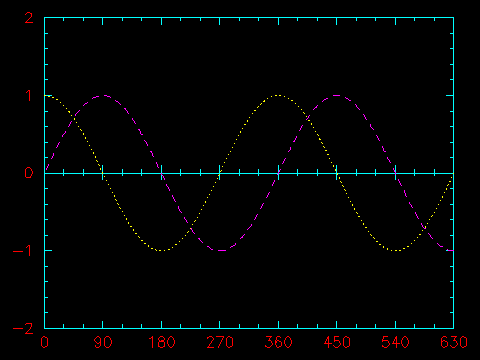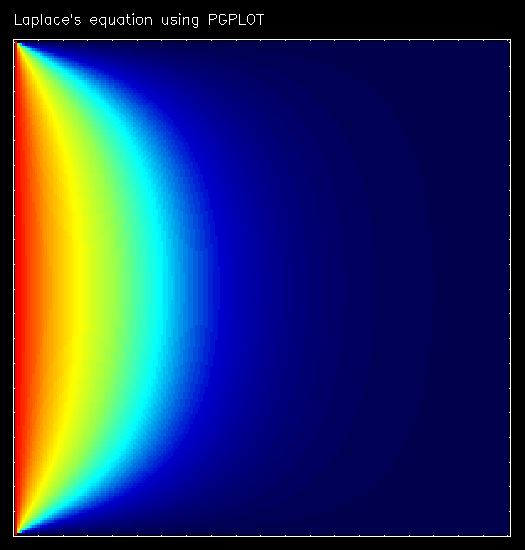PGPLOT
PGPLOT is a multi-platform plotting library mainly written in FORTRAN 77, with interfaces available for several other languages (such as C, C++, Perl, or Tcl/Tk). The development started in 1983, by T. J. Pearson at California Institute of Technology. The last version was released in February 2001 (v. 5.2.2). PGPLOT is not free software, but can be used in non-commercial projects without charge.

- Fig. 1: Output of PGPLOT example
pgdemo1.f
Installation
PGPLOT is available as a package on most Unix-like operating system. On
FreeBSD, just install graphics/pgplot:
# pkg install graphics/pgplotAny Fortran application just has to be linked against -lX11,
and either -lpgplot (shared library) or libpgplot.a
(static library) to access the PGPLOT procedures.
If a package is not provided, we can build the PGPLOT library from source. The source code archive is hosted on the Caltech FTP. First, download and unpack the archive:
$ fetch ftp://ftp.astro.caltech.edu/pub/pgplot/pgplot5.2.tar.gz
# tar xfvz pgplot5.2.tar.gz
# cd pgplot/Select the desired output device drivers in file
drivers.list, and then create a Makefile with
makemake. In this case, the output directory is set to
./, and the targeted platform to FreeBSD:
$ ./makemake ./ freebsdList the available platforms with:
$ ./makemake ./ operating_system
The second argument must be one of the following operating systems:
aix alliant arc bsd convex cray cygwin dos epix2 freebsd fujitsu gnuwin32 hp
irix linux mac msdos next openstep osf1 salford sol2 solx86 sun4 ultrix vms winFinally, run the Makefile to build the library:
$ make FCOMPL=gfortran14 CFLAGC=-I/usr/local/include/ LIBS="-L/usr/local/lib/ -lX11 -lm" Instead of passing the build options as arguments, simply alter the Makefile
according to your set-up. The predefined paths most likely do not match the
actual paths on modern Linux and Unix systems. Afterwards, the static libary
libpgplot.a is written to the given output directory
./.
PGPLOT includes 17 example programs to demonstrate its capabilities (fig. 1). To compile them individually, run, for instance:
$ cd examples/
$ gfortran14 -o pgdemo1 pgdemo1.f -lpgplot -lX11
$ ./pgdemo1
- Fig. 2: PGPLOT output of Laplace’s equation solver
Example
The following example program solves Laplace’s equation
numerically for a two-dimensional function f. After 8000
iterations, the result is plotted as a heatmap to an X window by PGPLOT
(fig. 2). Set the output device to /GIF to write the plot to
file pgplot.gif, or to ? to select the device at
run-time.
! laplace.f90
program main
implicit none (type, external)
external :: pgclos, pgimag ! PGPLOT imports (FORTRAN 77).
integer, parameter :: N = 200 ! Number of columns, rows.
integer, parameter :: NITER = 8000 ! Number of interations.
real :: f(N, N)
real :: vm(6)
real :: fmax, fmin
integer :: rc
! Initialise PGPLOT.
call pgplot_init('/XWINDOW', N, N, vm, rc)
if (rc < 0) stop 'Error: Failed to open output device'
! Set initial values.
f( 1, :) = 1.0
f(2:, :) = 0.0
! Solve Laplace's equation.
call laplace(f, NITER, 0.1**2, 0.1**2)
! Get minimum and maximum value.
fmin = minval(f)
fmax = maxval(f)
! Plot the heatmap.
call pgimag(f, N, N, 1, N, 1, N, fmin, fmax, vm)
! Close the graphics device.
call pgclos()
contains
subroutine laplace(a, niter, dx2, dy2)
real, intent(inout) :: a(:, :)
integer, intent(in) :: niter
real, intent(in) :: dx2
real, intent(in) :: dy2
integer :: i, m, n
n = size(a, 1)
m = size(a, 2)
do i = 1, niter
a(2:n - 1, 2:m - 1) = ((a(3:, 2:m - 1) + a(:m - 2, 2:m - 1)) * dy2 + &
(a(2:n - 1, 3:) + a(2:n - 1, :m - 2)) * dx2) / &
(2 * (dx2 + dy2))
end do
end subroutine laplace
subroutine pgplot_init(gd, n, m, vm, stat)
!! Opens the given graphics device, sets the transformation matrix,
!! initialises PGPLOT, and sets the colour palette.
integer :: pgopen
external :: pgbox, pgctab, pgenv, pgmtxt, pgwnad
character(len=*), intent(in) :: gd
real, intent(out) :: vm(6)
integer, intent(in) :: n
integer, intent(in) :: m
integer, intent(out), optional :: stat
integer :: rc
real :: bright, contra
if (present(stat)) stat = -1
! Open the given graphics device.
rc = pgopen(gd)
if (rc < 0) return
! Set the coordinate transformation matrix. In this case, world coordinate
! equals pixel number.
vm = [ 0.0, 1.0, 0.0, 0.0, 0.0, 1.0 ]
! Set up window and viewport.
call pgwnad(0.0, 1.0 + n, 0.0, 1.0 + m)
! Add border and output text.
call pgbox('bcts', 0.0, 0, 'bcts', 0.0, 0)
call pgmtxt('t', 1.0, 0.0, 0.0, "Laplace's equation using PGPLOT")
! Set up the rainbow colour palette.
bright = 0.5; contra = 1.0
call pgctab([ -0.5, 0.0, 0.17, 0.33, 0.50, 0.67, 0.83, 1.0, 1.7 ], &
[ 0.0, 0.0, 0.0, 0.0, 0.6, 1.0, 1.0, 1.0, 1.0 ], &
[ 0.0, 0.0, 0.0, 1.0, 1.0, 1.0, 0.6, 0.0, 1.0 ], &
[ 0.0, 0.3, 0.8, 1.0, 0.3, 0.0, 0.0, 0.0, 1.0 ], &
9, contra, bright)
if (present(stat)) stat = 0
end subroutine pgplot_init
end program mainThe implicit none (type, external) statement is a Fortran 2018
feature and may not be supported by older compilers. Build and execute the above
example with:
$ gfortran14 -o laplace laplace.f90 -lpgplot -lX11
$ ./laplaceTo link against the PGPLOT static library, run instead:
$ gfortran14 -o laplace laplace.f90 /usr/local/lib/libpgplot.a -lX11Depending on the array size and the number of iterations, the solving may take several seconds.
Some aspects of PGPLOT can be configured through environment variables, such as font, foreground and background colour, or default output device, for example:
$ export PGPLOT_FOREGROUND=black
$ export PGPLOT_BACKGROUND=white
$ ./laplaceYou may have to specify the path to file rgb.txt in environment
variable PGPLOT_RGB.
Output Devices
PGPLOT supports a broad range of output devices, which depend on the used
platform and the selected build options. Only the /NULL device is
always available. The PGPLOT manual includes a
complete list
of interactive and non-interactive graphics devices. The parameter ?
will let PGPLOT ask the user to select from a list of supported devices (tab. 1
and 2).
-
Parameter Description /GTERMColor gterm terminal emulator /XTERMXTerm Tek terminal emulator /TK4100Tektronix 4100 terminals /XDISPpgdisp or figdisp server /XWINDOWX11 window /XSERVEA /XWINDOWwindow that persists for re-use - Tab. 1: Interactive devices in PGPLOT
-
Parameter Description /GIFGraphics Interchange Format file, landscape orientation /VGIFGraphics Interchange Format file, portrait orientation /HPGLHewlett Packard HPGL plotter, landscape orientation /VHPGLHewlett Packard HPGL plotter, portrait orientation /HPGL2Hewlett-Packard graphics /LATEXLaTeX picture environment /NULLNull device, no output /PPMPortable Pixel Map file, landscape orientation /VPPMPortable Pixel Map file, portrait orientation /PSPostScript file, landscape orientation /VPSPostScript file, portrait orientation /CPSColour PostScript file, landscape orientation /VCPSColour PostScript file, portrait orientation /WDX window dump file, landscape orientation /VWDX window dump file, portrait orientation - Tab. 2: Non-interactive devices in PGPLOT
Fortran Libraries
- PG2PLplot: Library that facilitates the transition from PGPLOT to PLplot
- button: Fortran library to use graphical buttons with PGPLOT
- giza: 2D scientific plotting that is callable through the PGPLOT API
References
- PGPLOT: Official website
- PGPLOT online manual
| < raylib | [Index] | PLplot > |